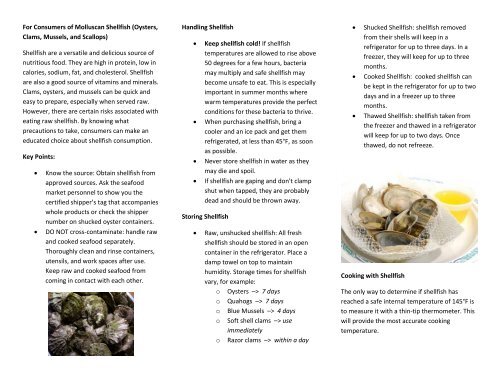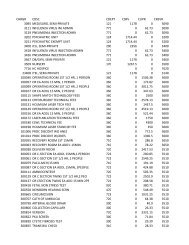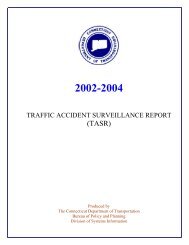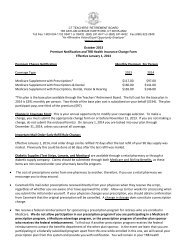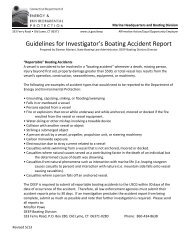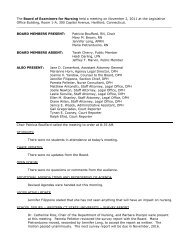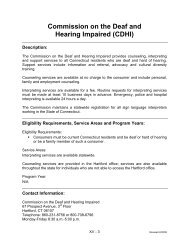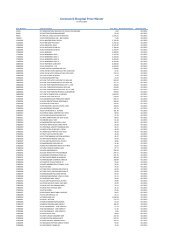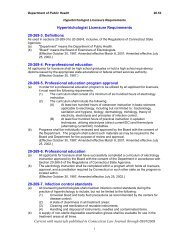For Consumers of Molluscan Shellfish (Oysters, Clams, Mussels ...
For Consumers of Molluscan Shellfish (Oysters, Clams, Mussels ...
For Consumers of Molluscan Shellfish (Oysters, Clams, Mussels ...
Create successful ePaper yourself
Turn your PDF publications into a flip-book with our unique Google optimized e-Paper software.
<strong>For</strong> <strong>Consumers</strong> <strong>of</strong> <strong>Molluscan</strong> <strong>Shellfish</strong> (<strong>Oysters</strong>,<br />
<strong>Clams</strong>, <strong>Mussels</strong>, and Scallops)<br />
<strong>Shellfish</strong> are a versatile and delicious source <strong>of</strong><br />
nutritious food. They are high in protein, low in<br />
calories, sodium, fat, and cholesterol. <strong>Shellfish</strong><br />
are also a good source <strong>of</strong> vitamins and minerals.<br />
<strong>Clams</strong>, oysters, and mussels can be quick and<br />
easy to prepare, especially when served raw.<br />
However, there are certain risks associated with<br />
eating raw shellfish. By knowing what<br />
precautions to take, consumers can make an<br />
educated choice about shellfish consumption.<br />
Key Points:<br />
<br />
<br />
Know the source: Obtain shellfish from<br />
approved sources. Ask the seafood<br />
market personnel to show you the<br />
certified shipper’s tag that accompanies<br />
whole products or check the shipper<br />
number on shucked oyster containers.<br />
DO NOT cross-contaminate: handle raw<br />
and cooked seafood separately.<br />
Thoroughly clean and rinse containers,<br />
utensils, and work spaces after use.<br />
Keep raw and cooked seafood from<br />
coming in contact with each other.<br />
Handling <strong>Shellfish</strong><br />
<br />
<br />
<br />
<br />
Keep shellfish cold! If shellfish<br />
temperatures are allowed to rise above<br />
50 degrees for a few hours, bacteria<br />
may multiply and safe shellfish may<br />
become unsafe to eat. This is especially<br />
important in summer months where<br />
warm temperatures provide the perfect<br />
conditions for these bacteria to thrive.<br />
When purchasing shellfish, bring a<br />
cooler and an ice pack and get them<br />
refrigerated, at less than 45°F, as soon<br />
as possible.<br />
Never store shellfish in water as they<br />
may die and spoil.<br />
If shellfish are gaping and don't clamp<br />
shut when tapped, they are probably<br />
dead and should be thrown away.<br />
Storing <strong>Shellfish</strong><br />
<br />
Raw, unshucked shellfish: All fresh<br />
shellfish should be stored in an open<br />
container in the refrigerator. Place a<br />
damp towel on top to maintain<br />
humidity. Storage times for shellfish<br />
vary, for example:<br />
o <strong>Oysters</strong> –> 7 days<br />
o Quahogs –> 7 days<br />
o Blue <strong>Mussels</strong> –> 4 days<br />
o S<strong>of</strong>t shell clams –> use<br />
immediately<br />
o Razor clams –> within a day<br />
<br />
<br />
<br />
Shucked <strong>Shellfish</strong>: shellfish removed<br />
from their shells will keep in a<br />
refrigerator for up to three days. In a<br />
freezer, they will keep for up to three<br />
months.<br />
Cooked <strong>Shellfish</strong>: cooked shellfish can<br />
be kept in the refrigerator for up to two<br />
days and in a freezer up to three<br />
months.<br />
Thawed <strong>Shellfish</strong>: shellfish taken from<br />
the freezer and thawed in a refrigerator<br />
will keep for up to two days. Once<br />
thawed, do not refreeze.<br />
Cooking with <strong>Shellfish</strong><br />
The only way to determine if shellfish has<br />
reached a safe internal temperature <strong>of</strong> 145°F is<br />
to measure it with a thin-tip thermometer. This<br />
will provide the most accurate cooking<br />
temperature.
Additional recommendations include:<br />
<br />
<br />
The Food and Drug Administration<br />
(FDA) suggests boiling shucked oysters<br />
for 3 minutes, frying them in oil at<br />
375°F for 10 minutes, or baking them at<br />
450°F for 10 minutes.<br />
<strong>Clams</strong>, mussels and oysters in the shell<br />
will open when cooked. The FDA<br />
suggests steaming oysters for 4 to 9<br />
minutes or boiling them for 3 to 5<br />
minutes after they open.<br />
Depending on size, scallops take 3 to 4<br />
minutes to cook thoroughly.<br />
Keep in mind that some people are at greater<br />
risk for foodborne illness, and should not eat<br />
raw or partially cooked fish or shellfish. These<br />
susceptible groups include:<br />
<br />
<br />
<br />
<br />
<br />
Pregnant women<br />
Young children<br />
Older adults<br />
Persons whose immune systems are<br />
compromised<br />
Persons who have decreased stomach<br />
acidity<br />
If you are unsure <strong>of</strong> your risk, ask your<br />
healthcare provider. If you feel ill after<br />
consuming raw shellfish, contact your primary<br />
care physician for evaluation and assessment.<br />
This information has been compiled by the<br />
Connecticut Sea Grant Extension Program with<br />
permission from the following sources:<br />
Connecticut Department <strong>of</strong> Agriculture Bureau<br />
<strong>of</strong> Aquaculture, Connecticut Department <strong>of</strong><br />
Public Health, Connecticut Department <strong>of</strong><br />
Consumer Protection, University <strong>of</strong> Delaware<br />
Sea Grant College Program, Washington State<br />
Department <strong>of</strong> Public Health, and FDA.<br />
<strong>For</strong> more information contact the Connecticut<br />
Department <strong>of</strong> Agriculture Bureau <strong>of</strong><br />
Aquaculture at 203-874-0696.<br />
<strong>For</strong> additional information and great recipes<br />
check out the following websites:<br />
www.ecsga.org<br />
www.seafoodhealthfacts.org<br />
http://www.seagrant.uconn.edu/<br />
FOR<br />
CONSUMERS<br />
OF<br />
MOLLUSCAN<br />
SHELLFISH<br />
SAFE HANDLING,<br />
STORAGE, AND COOKING<br />
PRACTICES<br />
CTSG – 13 - 11


